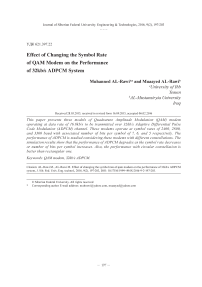Effect of changing the symbol rate of QAM modem on the performance of 32kb/s ADPCM system
Автор: Al-Rawi Muhanned, Al-Rawi Muaayed
Журнал: Журнал Сибирского федерального университета. Серия: Техника и технологии @technologies-sfu
Статья в выпуске: 2 т.9, 2016 года.
Бесплатный доступ
This paper presents three models of Quadrature Amplitude Modulation (QAM) modem operating at data rate of 16.8kb/s to be transmitted over 32kb/s Adaptive Differential Pulse Code Modulation (ADPCM) channel. These modems operate at symbol rates of 2400, 2800, and 3360 baud with associated number of bits per symbol of 7, 6, and 5 respectively. The performance of ADPCM is studied considering these modems with different constellations. The simulation results show that the performance of ADPCM degrades as the symbol rate decreases or number of bits per symbol increases. Also, the performance with circular constellation is better than rectangular one.
Qam modem, 32kb/s adpcm
Короткий адрес: https://sciup.org/146115055
IDR: 146115055 | УДК: 621.397.22 | DOI: 10.17516/1999-494X-2016-9-2-197-203
Текст научной статьи Effect of changing the symbol rate of QAM modem on the performance of 32kb/s ADPCM system
Exhaustive work had been done to accommodate high speed voiceband data signal either by modifying the algorithm of ADPCM [15-25] or by modifying the model of data transmission [22, 26-27]. One way of modifying the model of data transmission is to use different constellations of Quadrature Amplitude Modulation (QAM) signal.
Structure of adpcm
The algorithm of 32 kb/s ADPCM which is described here is as in CCITT G.726 [15]. Fig. 1 shows simplified block diagram of ADPCM codec. Two major components form the algorithm: an adaptive quantizer and an adaptive predictor. The relation between the encoder and the decoder is also depicted. The difference between them is that the encoder has adaptive quantizer( Q ) and inverse adaptive quantizer( Q-1 ) ,while, the decoder has inverse adaptive quantizer only. The decoder is simply a subset of the encoder and transmits r(n) as its output instead of c(n). The adaptive predictor, which is composed of two poles and six zeros, computes an input signal estimate ŝ(n) which is subtracted from input signal s(n) resulting in a difference signal d(n). The adaptive quantizer codes d(n) into 4-bit codeword c(n) which is sent over the transmission facility. At the receiving end, an ADPCM decoder uses c(n) to attempt to reconstruct the original signal s(n). Actually, only r(n) can be reconstructed which is related to the original input signal s(n) by
r(n) = s(n) + e(n) (1)
where
e(n) = dq(n) – d(n) = r(n) – s(n) (2)
is the error introduced by the quantizer, and dq(n) is the output of inverse adaptive quantizer
A typical measure of the ADPCM performance is given by signal-to-noise ratio (SNR)
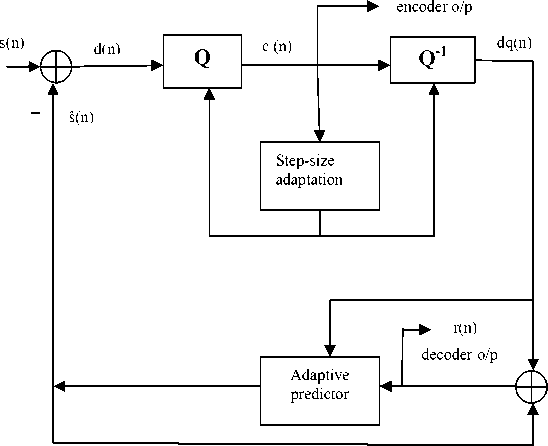
SNR= E[s2(n)]/E[e2(n)] = σ s 2/ σ e 2
Where E denotes expectation, σ s 2 is the power (or variance) of input signal, &σ e 2 is the power (or variance) of the error signal.
Qam modem
Computer simulation test
A series of computer simulation tests have been carried out on ADPCM codec using the three QAM modem signals at 16.8kb/s with constellations shown in Figs.2-4. The performance of ADPCM is measured by calculating SNR in equation 3.
Table 1 shows the results of testing ADPCM using modem-I. It seems that the performance of ADPCM with circular constellation is better than rectangular one by approximately 0.3dB.
Table 2 shows the results of testing ADPCM using modem-II. It seems that the performance of ADPCM with circular constellation is better than rectangular one by approximately 0.4dB.
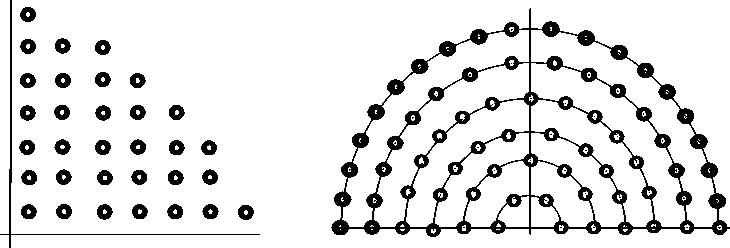
(a) Rectangular (b) (6,12,18,24,30,38)
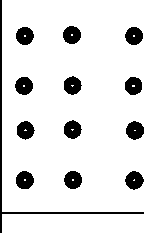
о
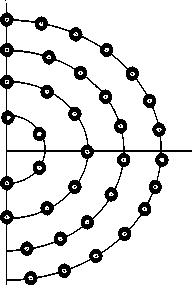
(a) Rectangular
Fig. 3. 64-ary QAM constellations
(b) (6,12,19,27)
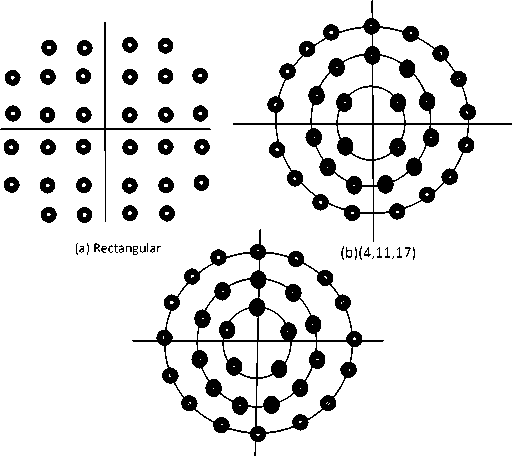
(c)(5,11,16)
Fig. 4. 32-ary QAM constellations
Table 3 shows the results of testing ADPCM using modem-III. It seems that the performance of ADPCM with circular constellation is better than rectangular one by approximately 0.5dB.
The comparison among the three modems shows that the performance of ADPCM with modem-III is better than its performance with modem-II by approximately 1.1dB and the later is better than modem-I by approximately 1.2dB .
Summary and conclusion
Three QAM modems operate at data rate of 16.8kb/s have been considered in order to reduce the nonlinear distortion of ADPCM. The simulation results show that the performance of ADPCM with – 201 –
Table 1. Performance of ADPCM
|
Modem-I |
||
|
SNR(dB) |
Rect |
(6,12,18,24,30,38) |
|
19.7 |
20 |
|
Table 2. Performance of ADPCM
|
Modem-II |
||
|
SNR(dB) |
Rect |
(6,12,19,27) |
|
20.9 |
21.3 |
|
Table 3. Performance of ADPCM
Refrences
-
[1] 32kb/s ADPCM, CCITT Recommendation G.721-1984.
-
[2] Jahangiri E. and Ghaemmghami S. Very low rate scalable speech coding through classified embedded matrix quantization. EURASIP Journal on Advances in Signal Processing , 2010.
-
[3] Coding of speech at 8kb/s using conjugate structure algebraic code excited linear prediction(CSACELP), ITU-T Recommendation G.729-1996.
-
[4] Patel J., Bachu G. and Barkana D.A comparison of LBG & ADPCM speech compression techniques. Proc. of IEEE International Joint Conference on Computer, Information, Systems Sciences, and Engineering , 2008.
-
[5] Dusan S., Flanagan L., Karve A. and Balaraman M. Speech compression by polynomial approximation. IEEE Transaction on Audio, Speech, & Language Processing , 2007, 15(2), 387-395.
-
[6] Chu W. Speech Coding Algorithms: Foundation and Evolution of Standardized Coders . John Wiley & Sons, New York, USA, 2003.
-
[7] Chu W. A scalable MELP coder based on embedded quantization of the line spectral frequencies. Proc. of International Symposium on Intelligent Signal Processing & Communication Systems , Hong Kong, 2005.
-
[8] Sanjeev K. Stabilization and glitch minimization for CCITT Recommendation G.726 speech codec during packet loss scenarios by regressor control and internal state updates of the decoding process . U.S. Patent 20090125302, May 14, 2009.
-
[9] Satish K., Mundra M. and Daniel C. Interoperability of ADPCM encoded voice communications . U.S. Patent 20060171372, Aug. 3, 2006.
-
[10] Chu L. Adaptive differential pulse code modulation/demodulation system and method . U.S. Patent 201001183092, July 22, 2010.
-
[11] Yen-Shih L. ADPCM encoding and decoding method and system with improved step size adaptation thereof . U.S. Patent 20080109219, May 8, 2008.
-
[12] Mark R., Yaakov C. and Eli F. Method and apparatus for smooth convergence during audio discontinuous transmission . U.S. Patent 20100260273, Oct. 14, 2010.
-
[13] Mark R. and Eli F. Adaptive error protection for wireless communications . U.S. Patent 20100138724, June 3, 2010.
-
[14] Lijun T. Rom addressing method for an ADPCM decoder implementation . U.S. Patent 20070153919, July 5, 2007.
-
[15] 40, 32,24,16 kb/s ADPCM, CCITT Recommendation G.726-1990.
-
[16] 5-,4-,3-,2- bit/sample embedded ADPCM, CCITT Recommendation G.727-1990.
-
[17] Mustafa H. and Bowker D. Overview and performance of CCITT/ANSI embedded ADPCM algorithm. IEEE Transaction on Communication , 1993, 41, 391-399.
-
[18] Comparison of ADPCM algorithms , ITU-T Recommendation G.726 Appendix III-1994.
-
[19] Digital circuit multiplication equipment using G.726 ADPCM & digital speech interpolation, ITU-T Recommendation G.763-1998.
-
[20] ADPCM DCME configuration map report , ITU-T Recommendation G.776.3-2000.
-
[21] AL-Rawi M., Soegijoko S. and Samadikun S. Simulation results of newly designed ADPCM for data transmission at 9.6 kb/s. Proc. of Ninth International Conference on Microelectronics , Bandung, Indonesia, 1997.
-
[22] AL-Rawi M. Newly designed 9.6 kb/s data transmission system over various algorithms of ADPCM . Ph.D. Dissertation, Dept. Elect. Eng., Bandung Institute of Technology, Indonesia, 1998.
-
[23] Bevenuto N. and Daumer W. R. Two approaches for waveform coding of 9.6 kb/s voiceband data signals through 32 kb/s ADPCM. IEEE Transaction on Communication , 1988, 3, 382-385.
-
[24] Shampiro Z. Adaptive differential pulse code modulation system . U.S. Patent 4860313, 1989.
-
[25] AL-Rawi M. and AL-Rawi M. Comparative study of 24kb/s ADPCM algorithms. Radioelectronics and Communications Systems-Springer , 2014, 57(6).
-
[26] AL-Rawi M., Soegijoko S. and Samadikun S. Computer simulation for newly designed 9.6 kb/s data transmission system over standard ADPCM. Proc. of Ninth International Conference on Microelectronics. Bandung, Indonesia, 1997.
-
[27] AL-Rawi M. and AL-Rawi M. Analysis and design of ADPCM system. Journal of Advanced Engineering , 2015, 10(3), 125-127.
-
[28] A modem operating at data signaling rates of up to 33600bit/s for use on the general switched telephone network and on leased point-to point 2-wire telephone-type circuits , CCITT Recommendation V.34-1998.
-
[29] Melvil T., Thomas C. and Weidner M. Digital amplitude-phase keying with M-ary alphabets. IEEE Transaction on Communication , 1974, 22(2), 168-180.
Список литературы Effect of changing the symbol rate of QAM modem on the performance of 32kb/s ADPCM system
- 32kb/s ADPCM, CCITT Recommendation G.721-1984.
- Jahangiri E. and Ghaemmghami S. Very low rate scalable speech coding through classified embedded matrix quantization. EURASIP Journal on Advances in Signal Processing, 2010.
- Coding of speech at 8kb/s using conjugate structure algebraic code excited linear prediction(CSACELP), ITU-T Recommendation G.729-1996.
- Patel J., Bachu G. and Barkana D.A comparison of LBG & ADPCM speech compression techniques. Proc. of IEEE International Joint Conference on Computer, Information, Systems Sciences, and Engineering, 2008.
- Dusan S., Flanagan L., Karve A. and Balaraman M. Speech compression by polynomial approximation. IEEE Transaction on Audio, Speech, & Language Processing, 2007, 15(2), 387-395.
- Chu W. Speech Coding Algorithms: Foundation and Evolution of Standardized Coders. John Wiley & Sons, New York, USA, 2003.
- Chu W. A scalable MELP coder based on embedded quantization of the line spectral frequencies. Proc. of International Symposium on Intelligent Signal Processing & Communication Systems, Hong Kong, 2005.
- Sanjeev K. Stabilization and glitch minimization for CCITT Recommendation G.726 speech codec during packet loss scenarios by regressor control and internal state updates of the decoding process. U.S. Patent 20090125302, May 14, 2009.
- Satish K., Mundra M. and Daniel C. Interoperability of ADPCM encoded voice communications. U.S. Patent 20060171372, Aug. 3, 2006.
- Chu L. Adaptive differential pulse code modulation/demodulation system and method. U.S. Patent 201001183092, July 22, 2010.
- Yen-Shih L. ADPCM encoding and decoding method and system with improved step size adaptation thereof. U.S. Patent 20080109219, May 8, 2008.
- Mark R., Yaakov C. and Eli F. Method and apparatus for smooth convergence during audio discontinuous transmission. U.S. Patent 20100260273, Oct. 14, 2010.
- Mark R. and Eli F. Adaptive error protection for wireless communications. U.S. Patent 20100138724, June 3, 2010.
- Lijun T. Rom addressing method for an ADPCM decoder implementation. U.S. Patent 20070153919, July 5, 2007.
- 40, 32,24,16 kb/s ADPCM, CCITT Recommendation G.726-1990.
- 5-,4-,3-,2-bit/sample embedded ADPCM, CCITT Recommendation G.727-1990.
- Mustafa H. and Bowker D. Overview and performance of CCITT/ANSI embedded ADPCM algorithm. IEEE Transaction on Communication, 1993, 41, 391-399.
- Comparison of ADPCM algorithms, ITU-T Recommendation G.726 Appendix III-1994.
- Digital circuit multiplication equipment using G.726 ADPCM & digital speech interpolation, ITU-T Recommendation G.763-1998.
- ADPCM DCME confi guration map report, ITU-T Recommendation G.776.3-2000.
- AL-Rawi M., Soegijoko S. and Samadikun S. Simulation results of newly designed ADPCM for data transmission at 9.6 kb/s. Proc. of Ninth International Conference on Microelectronics, Bandung, Indonesia, 1997.
- AL-Rawi M. Newly designed 9.6 kb/s data transmission system over various algorithms of ADPCM. Ph.D. Dissertation, Dept. Elect. Eng., Bandung Institute of Technology, Indonesia, 1998.
- Bevenuto N. and Daumer W. R. Two approaches for waveform coding of 9.6 kb/s voiceband data signals through 32 kb/s ADPCM. IEEE Transaction on Communication, 1988, 3, 382-385.
- Shampiro Z. Adaptive differential pulse code modulation system. U.S. Patent 4860313, 1989.
- AL-Rawi M. and AL-Rawi M. Comparative study of 24kb/s ADPCM algorithms. Radioelectronics and Communications Systems-Springer, 2014, 57(6).
- AL-Rawi M., Soegijoko S. and Samadikun S. Computer simulation for newly designed 9.6 kb/s data transmission system over standard ADPCM. Proc. of Ninth International Conference on Microelectronics. Bandung, Indonesia, 1997.
- AL-Rawi M. and AL-Rawi M. Analysis and design of ADPCM system. Journal of Advanced Engineering, 2015, 10(3), 125-127.
- A modem operating at data signaling rates of up to 33600bit/s for use on the general switched telephone network and on leased point-to point 2-wire telephone-type circuits, CCITT Recommendation V.34-1998.
- Melvil T., Thomas C. and Weidner M. Digital amplitude-phase keying with M-ary alphabets. IEEE Transaction on Communication, 1974, 22(2), 168-180.

